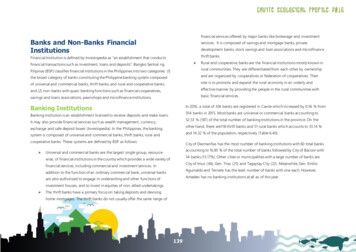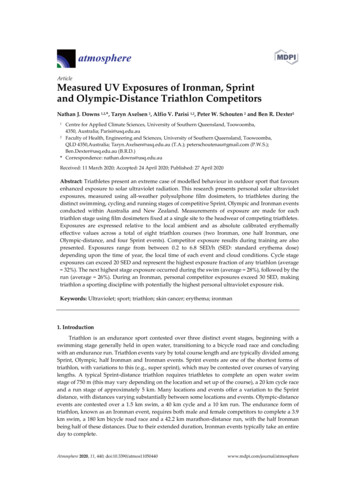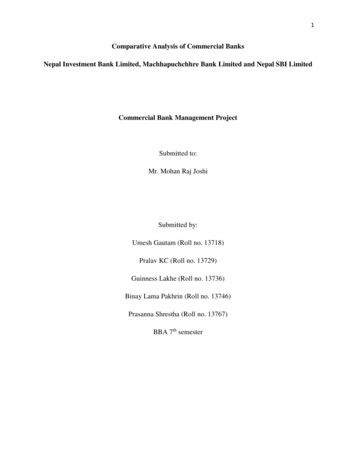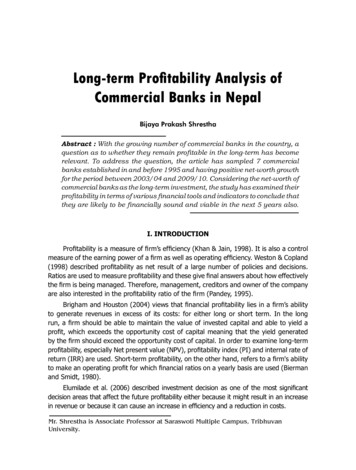
Transcription
Banks’ Risk Exposures Juliane BegenauMonika PiazzesiMartin SchneiderStanford & NBERStanford & NBERStanford & NBERDecember 2020AbstractThis paper studies U.S. banks’ exposure to interest rate and credit risk. We exploit thefactor structure in interest rates to represent many bank positions in terms of simple factorportfolios. This approach delivers time varying measures of exposure that are comparableacross banks as well as across the business segments of an individual bank. We also proposea strategy to estimate exposure due to interest rate derivatives from regulatory data onnotional and fair values together with the history of interest rates. We use the approach todocument stylized facts about the recent evolution of bank risk taking. Email addresses: juliane.begenau@gmail.com, piazzesi@gmail.com, schneidr@stanford.edu. We thank HuiChen, John Cochrane, Darrell Duffie, Isil Erel, Bob Hall, Lars Hansen, Anil Kashyap, Hanno Lustig, JonathanParker, Jean-Charles Rochet, David Scharfstein, Chris Sleet, John Taylor, Harald Uhlig and seminar participantsat the 38th Annual Federal Reserve Bank of St. Louis Fall Conference, Arizona State, Chicago Booth Econometricsand Statistics Workshop, Chicago Money & Banking, Duke, the 4th Banque de France—Bundesbank Conference inParis, the Conference in Honor of Sargent and Sims at the Federal Reserve Bank of Minneapolis, the Conferenceon Expectational Coordination at the College de France, CREI, the Econometric Society Meeting in Seoul, FederalReserve Board, the Federal Reserve Banks of Chicago, San Francisco, and New York, the “Macro Financial Modeling and Macroeconomic Fragility” Conference, NYU, MIT, Ohio State, Princeton University, the ShovenFest atStanford, SITE, Society of Economic Dynamics in Cyprus, Stanford, Stanford Conference in Quantitative Finance,UC Davis, Yale and Wharton.1
1IntroductionMacro-prudential policy decisions require knowledge of banks’exposures to macroeconomic riskfactors. For example, how would the value of bank positions change if interest rates were to riseor credit spreads were to widen? These questions cannot be answered by a quick look at bankregulatory lings. While banks supply accounting measures for a large number of xed incomepositions that di er in maturity and credit quality, those measures do not speak directly to riskexposures. For example, a bank might have a large position in high quality short-term loans thatis nevertheless less a ected by a change in interest rates or credit spreads than a small position inlow quality long-term securities.This paper measures banks’exposures to macroeconomic risk through their xed income positions by representing those positions in terms of simple factor portfolios. We start from balancesheet data in the U.S. Reports on Bank Conditions and Income (“Call Reports”). We focus ontwo orthogonal risk factors that capture large shares of interest rate and credit risk in xed income instruments held by banks. Both factors are portfolio returns: the interest rate factor is thereturn on a safe long term bond and the credit risk factor is the return on a leveraged portfoliothat is long in low quality bonds. We then represent each position in a bank’s balance sheet bytwo numbers: the dollar values of two factor portfolios that are a ected in exactly the same wayto the risk factors as the bank position over the next quarter.Factor portfolios provide measures of exposure that are easy to interpret and compare acrosspositions.1 They can also be added up over positions or entire banks. Consider, for example,the aggregate net xed income position ( xed income assets minus liabilities including derivativesand positions held for trading) of the U.S. banking sector at the end of 2013. We nd that U.S.banks jointly held a 4 trillion interest-rate factor portfolio. This portfolio declines in value wheninterest rates rise: a one standard deviation negative realization of the interest rate risk factor overQ1 2014 – that is, a typical upward shift in the level of the yield curve – would have generateda 120 billion loss. At the same time, U.S. banks held a 3.5 trillion credit-risk factor portfolio.This portfolio declines in value when credit spreads widen: a one standard deviation negativequarterly realization of the credit risk factor –that is, a typical increase in low quality yields thatis orthogonal to the level of the yield curve –would have generated a 80 billion loss.We nd that maturity transformation –e ectively borrowing short term and lending long term–is not only a key feature of banks’traditional business (loans and deposits), but also characterizesthe modern trading business of large banks, in particular their positions in interest rate derivatives.1In the above example, the large high quality short-term loan position would be represented by small amountsin both factor portfolios, whereas the small low quality long-term securities position would be represented by largeramounts.2
Indeed, U.S. banks’aggregate net xed income position at the end of 2013 was 2.3 trillion. Interms of exposure to interest rate risk, U.S. banks thus look like a leveraged portfolio that is long 4trillion in the interest rate factor (that is, safe long-term bonds), but short 4 trillion – 2.3 trillion 1.7 trillion in cash (that is, a safe short bond that induces no exposure).2 Banks’interest-ratederivatives positions show a similar pattern: they look like a highly leveraged portfolio that is long 1.2 trillion in the interest-rate factor and short 1.1 trillion in cash. Both derivatives and otherpositions thus decline in value when interest rates rise.We compute factor portfolios by position for every bank and every date in our sample. Theresults reveal a number of stylized facts about the evolution of bank risk taking over the last20 years. Interest-rate risk exposure rose substantially after the repeal of the Glass-Steagall actas larger banks increasingly engaged in trading activities, including interest-rate derivatives. Forlarge banks and those with a lot of trading business, credit risk exposure rose more slowly butthen spiked to peak together with interest rate risk exposure around the nancial crisis in 2008.In smaller banks and those with more traditional business, both risk exposures built up less beforethe crisis, but instead increased in its aftermath. This is true especially for credit risk in the loanportfolio. More generally, the cross section of banks shows considerable heterogeneity in bank risktaking as well as the role of derivatives.Formally, our calculations proceed in two steps. We rst use regressions to measure factorexposures for many xed income instruments. This step studies only the joint distribution ofreturns; bank position data are not used. We consider risk exposure over a xed horizon of onequarter. Our interest-rate risk factor is the one quarter return on a “safe bond” that re‡ectschanges in the level of the yield curve – speci cally, the return on a position in collateralizedinterest-rate swaps with a maturity of 5 years. Our credit risk factor is the return on a portfoliothat contains the safe bond as well as a 5 year BBB rated bond, with portfolio weights chosensuch that the portfolio return is conditionally uncorrelated with the safe bond return.For a broad class of instruments with di erent maturity, credit quality and payo structure,we regress returns on our two factors. To accommodate time variation in the comovement of bondreturns, we run separate regressions for every date, using only observations up to that date. Thisis also what a regulator who applies our approach could have done in real time. For every date,the resulting regression coe cients thus provide an estimate of how much the instrument returnwas expected to move with each factor over the next quarter. Equivalently, they describe a simpleportfolio that has the same conditional factor exposures as one dollar invested in the instrumenton that date. These conclusions are robust to the possible presence of other risk factors – any2More generally, representation of positions by factor portfolios allows us to view bank business as a leveraged"replicating" portfolio. For example, the exposures of the aggregate xed income position to both factors lookslike a leveraged portfolio that is long 4 trillion in interest rate risk, long 3.5 trillion in credit risk and short 5.2trillion in cash.3
such factors are subsumed in the error terms of the regressions and thus must be orthogonal tothe factors we consider.Our two factors explain a large share of variation in most instruments. For almost all maturitiesand credit qualities we consider, full sample R2 s lie above 70%; the exception is low quality shortterm instruments where the R2 is about 50%. The interest-rate factor alone explains the bulk ofthe variation in high quality instruments such as Treasuries and swaps. The credit-risk factor isinstead a key driver of low quality returns. Allowing for time variation in covariances is importantfor capturing the change in bond price dynamics during the nancial crisis. Indeed, in normaltimes decreases in safe interest rates make the price of all bonds increase together. What wasspecial in 2008-9 is that risky bond prices fell while safe bond prices increased. As a result,exposure of low quality bonds to interest-rate risk actually declined during this period.In a second step, we add bank regulatory data to derive position exposures. For securities,banks report fair values (typically market values) and provide detailed information on maturitiesand credit quality. We can thus directly apply instrument exposures from the rst step to restateeach position in terms of factor portfolios. For loans and many liabilities, we have to addressthe fact that banks report face values. We use information on maturity and interest rates to rstexpress those positions as streams of future payments, and then compute factor exposures for eachpayment. The main results are that banks’traditional business implies positive exposure to theinterest rate and credit risk factors. The former is due to holdings of securities and is concentratedmore at banks that engage in market making. The latter is due to loans and is important for allbanks.A key advantage of our portfolio approach is that it is conceptually straightforward to compute exposures via derivatives positions and compare them to exposure through other businesssegments. After all, returns on derivative instruments are readily available and can be regressedon factors to obtain measures of exposure. To the extent that regulatory lings contain detaileddata on derivatives positions, we can then infer bank exposures. The ideal data set for our purposes would contain information on market values of derivatives together with contract terms. Forexample, for interest rate swaps we would like to know the maturity, the locked in swap rate paidor received by the bank as well as the notional value.Unfortunately, call report data on derivatives is limited. While banks report market valuesfor all current positions, both positive and negative, they do not disclose the direction of trading.For example, when we observe a position with positive fair value at some date, we only know thatthe bank placed a bet that paid o up to that date, but not whether it was a bet on interest rateincreases (e.g. a pay- xed swap) or decreases (a pay-‡oating swap). Moreover, while there is someinformation on maturities, we do not have data on payo s such as swap rates or futures rates that4
banks locked in the past.To deal with the lack of reported information, we propose a Bayesian approach to estimatejointly the direction of trade and the relevant payo information. The basic idea for identi cationis that if a position with positive fair value is observed right after a period of falling interest rates,then it is more likely that the bank placed a bet on falling rates. Moreover, the size of the gains onthe position is informative about the di erence between the current interest rate and the interestrate locked in for the same maturity in the past. Identi cation of the bank’s strategy thus relieson the joint distribution of its net position and the history of interest rates. We also use data onbid-ask spreads and gross positions to account for the contribution of market maker rents to fairvalues.Our estimation nds that most banks’interest-rate derivatives trading works like a portfolioof pay-‡oating swaps: banks pay their counterparty a ‡oating rate and receive a xed rate inreturn. As a result, most banks gain on their derivatives positions when interest rate rates fallso the ‡oating rate they pay adjusts downward. In particular, we observe large gains for manybanks when the Fed lowered interest rates during the 2001 recession and more recently during the nancial crisis. While there is considerable heterogeneity in the use of derivatives – only abouthalf of U.S. banks use any interest rate derivatives and the derivatives market is dominated by afew banks –we nd little evidence that these positions are used to hedge other positions such asloans.Related literatureOur approach is related to a number of alternative ways to assess bank riskiness. The regulatoryframework currently being implemented is known as Basel III. Regulators ask banks to estimatedefault probabilities for instruments they hold either with (external) credit ratings or with internalmodels.3 They then determine capital requirements for each position separately. A convenientfeature of our approach is that factor portfolios are additive risk measures that are comparableacross positions; they could thus be used to develop risk measures for all or parts of a bank. Thisis an advantage over non-additive measures of risk such as VaR that are popular among someregulators (see e.g. Acharya, Pedersen, Phillipon, and Richardson 2010, Kelly, Lustig, and vanNieuwerburgh 2011 for discussions of measures of tail risk and Adrian and Boyarchenko 2012 formacroeconomic e ects of VaR constraints).Our approach is similar in spirit to the stress tests performed recently by regulators in manycountries. The typical stress test posits a set of scenarios, and banks are asked to report gains orlosses anticipated under each scenario (see, for example, Brunnermeier, Gorton, Krishnamurthy3Basel II regulators also make a distinction between credit risk due to borrower default and market risk due toprice changes. Our approach instead considers all risk re‡ected in returns. Default risk is accommodated to theextent that returns are low when there are many defaults.5
2012, Du e 2012, Greenlaw, Kashyap, Shin and Schoenholtz 2012). Banks may arrive at theiranswers by running scenarios in their internal models. A realization of our risk factors could alsotaken to be a stress scenario. Of course, our calculations not only provide a single number thatpredicts losses in one scenario, but allows us to compute moments such as conditional volatilities.Moreover, since we provide an algorithm that goes from raw positions to bank exposures via theexposures for each instrument class, we provide a transparent way to explore where the losses in astress scenario come from and how this depends on assumptions the distribution of xed incomereturns.There is a long tradition of relating bank performance measures to macroeconomic risk factors.One popular line of work regresses bank stock returns on a risk factor, such as an interest rate. Theregression coe cient on the interest rate –often referred to as the interest-rate beta –measuresthe average exposure of the bank’s overall value to interest rate changes over the sample periodconsidered (Flannery and James 1984a). More recently, Landier, Sraer and Thesmar (2013) haveconsidered alternative performance measures such as changes in interest income or earnings as afraction of assets.Our approach is complementary to studies based on overall performance measures. One the onehand, we only look at banks’ xed income positions. We do not capture, for example, the e ect ofrisk factors on banks’intangible assets (for example, the bank’s "franchise value") or compensationcosts. Such e ects would be captured by overall performance measures such as stock returns andearnings ratios, respectively. On the other hand, we proceed position-by-position and can traceout in detail how risk in banks’ xed income position is a ected.Another line of work considers average exposures in individual bank positions. One way toproceed is to directly regress position changes on candidate risk factors. Other studies rst computeaverage exposure measures such as interest rate betas from stock return regressions and then relatethose measures to summary statistics from bank positions.4 Both types of regression approachesare useful to understand average exposures over longer periods of time.5 In contrast, we areinterested in how exposures change over short periods of time such as during the nancial crisis;our approach delivers factor portfolios for every date in our sample.In particular, our estimation of interest rate derivatives positions derives a time series of exposures. We build on early work by Gorton and Rosen (1995) who also infer the direction oftrading from banks’positions. However, their data predates the introduction of mark-to-market4For example, interest-rate betas have been related to banks’ maturity gaps, that is, the di erence betweenbank assets and liabilities that mature within a speci ed horizon (Flannery and James 1984b). Moreover, changesin bank equity values have been related to o -balance sheet statistics that indicate derivative use (Venkatachalam1996).5Extensions have attempted to incorporate time-varying interest rate betas, but those have proven di cult toestimate (for example, Flannery, Hammed, and Haries 1997, Hirtle 1997).6
accounting rules that requires banks to report cumulative gains and losses at market value. As aresult, they were not able to infer time-varying exposures to interest rate risk through derivatives.We nd that banks mostly take pay-‡oating positions in interest-rate derivatives, which arepositions that gain in value from a surprise fall in interest rates. Some of the counterpartiesto these positions are non nancial corporations, who use pay- xed positions in swaps to insurethemselves against surprising interest-rate increases. Hentschel and Kothari (2001) and Chernenkoand Faulkender (2011) document these positions empirically. Jermann and Yue (2012) use atheoretical framework to study why non nancial corporations have a need for pay- xed swaps.Since the nancial crisis, there has been renewed interest in documenting the balance-sheetpositions of nancial institutions. We share the important goal of this literature: to come upwith data on positions that will inform the theoretical modeling of these institutions, as calledfor by Franklin Allen in his 2001 AFA presidential address. For example, Adrian and Shin (2011)investigate the behavior of Value-at-Risk measures reported by investment banks. They documentthat VaR per dollar of book equity stayed constant throughout the last decade, including the nancial crisis, when these institutions were deleveraging. He, Khang, and Krishnamurthy (2010)document the behavior of book values of balance sheet positions of various nancial institutions.The paper is structured as follows. Section 2 provide an overview of our approach and illustratesits bene ts by showing results for a particular bank and date, JPMorgan Chase at the end of2013. Section 3 describes the data. Section 4 provides details on the rst step of our analysis,the estimation of exposures for individual xed income instruments. Section 5 describes in detailhow we represent banks xed-income balance sheet positions. Section 6 explains our method toderive a factor portfolio representation of a bank’s interest rate derivative position. Sect
For example, a bank might have a large position in high quality short-term loans that is nevertheless less a ected by a change in interest rates or credit spreads than a small position in low quality long-term securities. This paper measures banks expo











